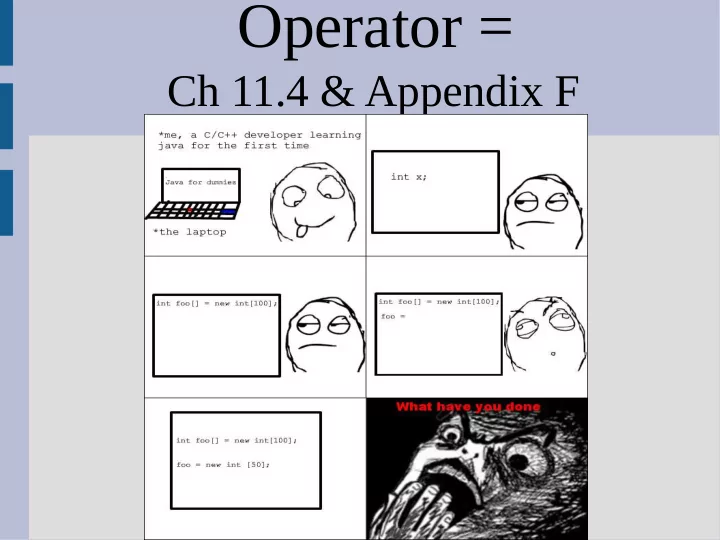

Operator = Ch 11.4 & Appendix F
Announcements Midterm 1 scores on moodle now - has +6 point adjustment
Highlights - Overload equals
Review: Copy constructor To avoid double deleting (crashes program) or multiple pointers looking at the same spot... We have to redefine the copy constructor if we use dynamic memory The copy constructor is another special constructor (same name as class): copy constructor
Review: Copy constructor When exactly does a copy constructor run? 1. You use an '=' sign with classes 2. You call-by-value a class as an input to a function (i.e. do not use &) (3. You return an inputted class to function) (see: copyCout.cpp)
Copy constructor: arrays How would you copy a dynamically created array inside a class? What if this was a normal array? (see: copyArray.cpp)
Copy constructor vs. '=' There is actually two ways in which you can use the '=' sign... 1. The copy constructor, if you ask for a box on that same line 2. Operator overload, if you already have a box when using '='; (See: copyVsEquals.cpp)
Overload = What is the difference between copy and '='?
Overload = What is the difference between copy and '='? “copy” is a constructor, so it creates new boxes '=' is changing the value of an existing box (but same idea: not sharing the same address) The “proper” way to implement '=' is nuanced... see code comments if you care (See: overloadEquals.cpp)
TLDR When using “new” in a constructor, you also should make: 1. Destructor 2. Copy constructor 3. Overload '=' operator Typically the built-in functions are not sufficient if you use a “new” or '*'
this Consider the following code: How do we write getX() and getMe()?
this Q: It seems you should have information about yourself, but how do you access that? A: Inside every class, there is a this pointer, that points to yourself this points to itself (See: thisSelfPointer.cpp)
typedef Side note: If you want to rename types, you can do that with typedef command: original name new synonymous name (See: redefiningTypes.cpp) If you have always been bothered that we use “double” instead of “real”, go ahead and fix it!
Recommend
More recommend